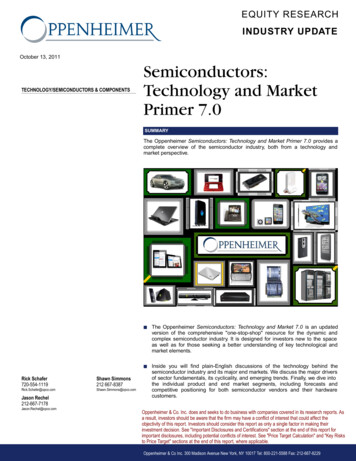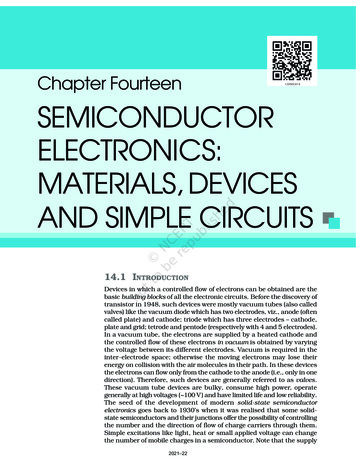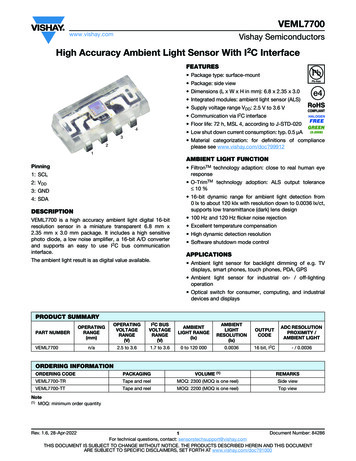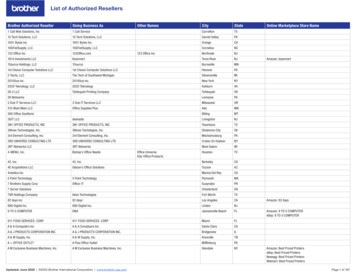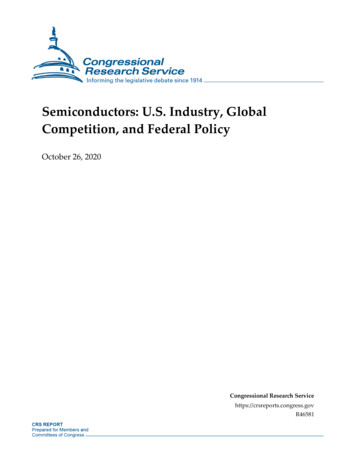
Transcription
Semiconductors: U.S. Industry, GlobalCompetition, and Federal PolicyOctober 26, 2020Congressional Research Servicehttps://crsreports.congress.govR46581
SUMMARYSemiconductors: U.S. Industry, GlobalCompetition, and Federal PolicySemiconductors, tiny electronic devices based primarily on silicon or germanium, enable nearlyall industrial activities, including systems that undergird U.S. technological competitiveness andnational security. Many policymakers see U.S. strength in semiconductor technology andfabrication as vital to U.S. economic and national security interests. The U.S. semiconductorindustry dominates many parts of the semiconductor supply chain, such as chip design.Semiconductors are also a top U.S. export. Semiconductor design and manufacturing is a globalenterprise with materials, design, fabrication, assembly, testing, and packaging operating acrossnational borders. Six U.S.-headquartered or foreign-owned semiconductor companies currentlyoperate 20 fabrication facilities, or fabs, in the United States. In 2019, U.S.-based semiconductormanufacturing directly employed 184,600 workers at an average wage of 166,400.R46581October 26, 2020Michaela D. PlatzerSpecialist in IndustrialOrganization and BusinessJohn F. Sargent Jr.Specialist in Science andTechnology PolicyKaren M. SutterSpecialist in Asian Tradeand FinanceSome U.S.-headquartered semiconductor firms that design and manufacture in the United Statesalso have built fabrication facilities overseas. Similarly, U.S.-headquartered design firms that donot own or operate their own fabrication facilities contract with foreign firms located overseas tomanufacture their designs. Much of this overseas capacity is in Taiwan, South Korea, and Japan,and increasingly in China. Some Members of Congress and other policymakers are concerned that only a small share of theworld’s most advanced semiconductor fabrication production capacity is in the United States. Other have becomeincreasingly concerned about the concentration of production in East Asia and related vulnerability of semiconductor supplychains in the event of a trade dispute or military conflict and other risks such as product tampering and intellectual propertytheft.Some Members of Congress and other U.S. policymakers have expressed concerns about the economic and militaryimplications of a loss of U.S. leadership in semiconductors. China’s state-led efforts to develop an indigenous verticallyintegrated semiconductor industry are unprecedented in scope and scale. Many policymakers are concerned that these efforts,if successful, could significantly shift global semiconductor production and related design and research capabilities to China,undermining U.S. and other foreign firms’ leading positions. Although China’s current share of the global industry is stillrelatively small and its companies produce mostly low-end chips, China’s industrial policies aim to establish globaldominance in semiconductor design and production by 2030. Moreover, Chinese semiconductor competencies could supporta range of technology advancements, including military applications. Another issue for policymakers is how to addresscompeting interests: China is an important market for U.S. semiconductor firms but U.S. and foreign industry are helping toadvance China’s capabilities. China’s government outlays (an estimated 150 billion to date) and its role as a centralproduction point for global consumer electronics are generating strong incentives and pressures on U.S. and foreign firms tofocus on China. The Chinese government views access to foreign capabilities in the near term as a key pathway to accelerateChina’s indigenous development. Also of concern to many are China’s state-led efforts to acquire companies and accesssemiconductor technology through both licit and illicit means; targeted intellectual property (IP) theft; and technologytransfer pressures.Issues before Congress include the appropriate role of government in assisting U.S. industry; how best to focus federalfinancial assistance; the amount of funding each proposed activity would need to accomplish its goals for sustaining U.S.semiconductor competitiveness; how to coordinate and integrate federal activities internally and with initiatives of the U.S.semiconductor and related industries; and how to address China’s ambitious industrial plans, trade practices of concern, andthe role of U.S. firms in China’s emerging semiconductor market. Legislation has been introduced in the 116th Congress toincrease federal funding for semiconductor research and development efforts; collaboration between government, industry,and academic partners; and tax credits, grants, and other incentives to spur U.S. production. Two bills under consideration arethe Creating Helpful Incentives to Produce Semiconductors (CHIPS) for America Act (S. 3933/H.R. 7178) and the AmericanFoundries Act (AFA) of 2020 (S. 4130). Some of the provisions of these acts have been included in other bills.Congressional Research Service
Semiconductors: U.S. Industry, Global Competition, and Federal PolicyContentsIntroduction . 1Semiconductor Industry Basics . 2Semiconductor History and Technological Challenges . 4Wafer Size . 5Feature Size. 6The Global Semiconductor Industry . 6Semiconductor Market Segments . 8Global Semiconductor Production . 9Materials Used for Wafer Manufacturing. 10Design; Fabrication; and Assembly, Testing, and Packaging . 11Design . 12Fabrication: Facilities (Foundries) . 14Fabrication: Equipment and Other Suppliers . 15Assembly, Testing, and Packaging . 17Key Parts of the Global Semiconductor Supply Chain . 17Global Semiconductor Fabrication Capacity . 18The U.S. Semiconductor Manufacturing Industry. 18Industry R&D Spending . 19Semiconductor Manufacturing Jobs . 19Semiconductor Production in the United States . 20The Global Semiconductor Landscape . 23East Asia . 24China . 26U.S. Controls on Semiconductors . 31Europe . 34The Federal Role in Semiconductors . 35Current Federal R&D Efforts to Develop Potential Technology Alternatives andSupplements to Semiconductors . 36National Security Concerns . 39DOD Trusted Foundry Program . 40Current Semiconductor-Related Legislation . 43Concluding Observations . 44FiguresFigure 1. Semiconductors: An Enabling Technology . 3Figure 2. Evolution of Silicon Wafer Size . 5Figure 3. Worldwide and U.S. Semiconductor Industry Sales . 7Figure 4. Global Semiconductor Industry Market Share, by Sales, 2019 . 7Figure 5. Typical Global Semiconductor Production Pattern . 10Figure 6. Integrated Circuit End-Use Markets and Estimated Growth Rates. 13Congressional Research Service
Semiconductors: U.S. Industry, Global Competition, and Federal PolicyFigure 7. U.S. Exports to China, Share of U.S. Exports to the World of SemiconductorFabrication Equipment . 16Figure 8. Revenue for Value Chain Segments by Headquarters Location, 2018. 17Figure 9. Semiconductor Industry Market Share, by Sales, 2019 . 24TablesTable 1. Semiconductor Fabrication Capacity . 18Table 2. Top 10 States in Semiconductor Manufacturing Employment . 20Table 3. 300mm (12-inch) Semiconductor Fabs in the United States, 2019 . 22Table 4. Worldwide 300mm Semiconductor Fab Count. 26Table 5. Examples of Abandoned or Blocked Chinese Semiconductor Transactions . 32Table B-1. The Top 15 Semiconductor Suppliers Worldwide . 50AppendixesAppendix A. History of the Federal Role in Semiconductor Development andCompetition . 47Appendix B. Top 15 Semiconductor Suppliers Worldwide . 50Appendix C. Semiconductor-Related Legislation in the 116th Congress . 51ContactsAuthor Information. 53Congressional Research Service
Semiconductors: U.S. Industry, Global Competition, and Federal PolicyIntroductionSemiconductors, tiny electronic devices based primarily on silicon or germanium, are a uniquelyimportant enabling technology. They are fundamental to nearly all modern industrial and nationalsecurity activities, and they are essential building blocks of other emerging technologies, such asartificial intelligence, autonomous systems, 5G communications, and quantum computing. Formore than six decades, consistent growth in semiconductor capabilities and performance andconcurrent cost reductions have boosted U.S. economic output and productivity and enabled newproducts, services, and industries.Since the immediate post-World War II era, the United States has been a global leader in theresearch, development, design, and manufacture of semiconductors. The United States remains aleader in semiconductor research and development (R&D), chip design, and some aspects ofsemiconductor manufacturing, but a complex mix of both U.S. and foreign companies makes upthe semiconductor supply chain, including fabrication facilities, or fabs. Nevertheless, in 2019,the United States accounted for 11% of global semiconductor fabrication capacity, down from13% in 2015, continuing a long-term decline from around 40% in 1990.1Many policymakers see the competitiveness of the U.S. semiconductor industry, includingdomestic production of semiconductors and the retention of manufacturing knowledge, humanexpertise, and hands-on experience, as vital to U.S. economic and national security interests.2Several factors contribute to congressional concerns about the competitiveness of the U.S.semiconductor industry: Sustaining the ability of the industry to continually improve semiconductorperformance while decreasing cost through technological innovation.Because semiconductors are integral components in almost all industrial activityand fundamental to several emerging technologies, their performance and priceaffect multiple sectors and the broader U.S. economy. Retaining and growing high-skilled and high-paying semiconductor industryjobs in the United States. Semiconductor manufacturing jobs in the UnitedStates pay twice that of the average U.S. manufacturing job.The movement of many U.S. firms toward a “fabless” business model. In thismodel, fabless semiconductor and related firms focus on R&D and designcapabilities, while contracting with outside, mostly foreign, fabricationcompanies.3 This fabless trend has contributed to a concentration of global chipproduction among a handful of firms operating fabs in East Asia. U.S. reliance on global supply chains and production concentrated in EastAsia and vulnerability to disruption or denial due to trade disputes orBy 2019, Taiwan, South Korea, and Japan accounted for two-thirds of the world’s semiconductor fabrication capacity,and China for 12% of global fabrication.2 Executive Office of the President, President’s Council of Advisors on Science and Technology, Report to thePresident: Ensuring Long-Term U.S. Leadership in Semiconductors, January 2017, lt/files/microsites/ostp/PCAST/pcast ensuring longterm us leadership in semiconductors.pdf. Also, see Senate floor debate on the National Defense Authorization Actfor Fiscal Year 2021, Congressional Record, vol. 166, part 128 (July 21, 2020), p. S. 4325.3 Beginning in the 1980s, some semiconductor companies began to contract for their fabrication needs rather thanmaintaining their own fabrication facilities. These firms became known as “fabless” firms. Also, some companies suchas Apple that are not classified as semiconductor companies design their own semiconductor chips and contract fortheir manufacturing.1Congressional Research Service1
Semiconductors: U.S. Industry, Global Competition, and Federal Policymilitary conflict. Manufacturing disruptions during the Coronavirus Disease2019 (COVID-19) pandemic have exacerbated this concern. Successivepresidential administrations and many in Congress have asserted the need toretain and expand advanced domestic semiconductor fabrication plants. China’s emerging strength in semiconductors supported through a state-ledeffort to establish itself as a global leader across the supply chain by 2030.Although China’s wafer fabrication is at least a generation behind the globalindustry in technology, it appears to be catching up through foreign technologyacquisition, collaboration, and transfer. This includes the use of joint ventures,licensing agreements, U.S.-led open source technology platforms for chip design,as well as the hiring of foreign talent and the purchase of U.S. equipment andsoftware tools.Assuring access to secure semiconductors for military systems. Through itsTrusted Foundry program, the Department of Defense (DOD) has, for over adecade, relied on a single U.S.-based foundry to supply secure, leading-edgesemiconductors. Concerns about the sustainability and adequacy of this approachhas generated interest in alternatives, including access to a broader range ofcommercial, state-of-the-art design and fabrication capabilities.Although some countries, including the United States, support their domestic semiconductorindustry, the scope and scale of China’s state-led efforts are unprecedented. China’s approach hasthe potential to shift global semiconductor production and related design and research capabilitiesto China, a development that could affect the competitiveness of U.S. firms. China’s efforts arealso of concern to many policymakers because they undermine global rules (e.g., state financingof industry and acquisitions, forced technology transfer, and intellectual property theft). Whilesome aspects of the China semiconductor challenge are unique, the U.S. response to the challengeposed by the Japanese government and its semiconductor industry in the 1980s offers context. Fora discussion of the federal policies and investments at that time, including a multiyear, 1.7billion federal investment in SEMATECH, an industry consortium of U.S. semiconductor firms,see Appendix A.This report discusses the technical challenges the semiconductor industry faces, domestic andglobal supply chains, secure and trusted production of semiconductors for national security, andfederal policies. This report also discusses current legislation to address these concerns, includingfederal assistance for the domestic semiconductor industry and funding for research anddevelopment (R&D) activities.Semiconductor Industry BasicsA semiconductor (also known simply as an integrated circuit, a microelectronic chip, or acomputer chip) is a tiny electronic device (generally smaller than a postage stamp) composed ofbillions of components that store, move, and process data.4 All of these functions are madepossible by the unique properties of semiconducting materials, such as silicon and germanium,which allow for the precise control of the flow of electrical current. Semiconductors are used formany purposes in many types of products—for example, to run software applications and to4Organisation for Economic Co-operation and Development (OECD), Measuring Distortions in International Markets:The Semiconductor Value Chain, November 21, 2019, p. 12, at rtions-in-international-markets 8fe4491d-en. A semiconductor is a name given to materials with unique electricalproperties falling between a conductor and an insulator; products made from these materials are also referred to assemiconductors.Congressional Research Service2
Semiconductors: U.S. Industry, Global Competition, and Federal Policytemporarily store documents. Semiconductors provide data storage and communicationcapabilities of countless other products, including mobile phones, gaming systems, aircraftavionics, industrial machinery, and military equipment and weapons. Many products with roots inmechanical systems—such as manufacturing equipment—heavily depend on chip-basedelectronics. Modern automobiles illustrate the ubiquitous role of semiconductors in devices thatwere once only mechanical and chemical in function. According to one analysis, some hybridelectric automobiles may now contain as many as 3,500 semiconductors.5 Semiconductor chipsare fundamental to emerging technological applications such as artificial intelligence, cloudcomputing, 5G, the Internet-of-Things (IoT), and large-scale data processing and analytics andsupercomputing.6 (See Figure 1.)Figure 1. Semiconductors: An Enabling TechnologySource: Alex Capri, “Semiconductors at the Heart of the U.S.-China Tech War: How a New Era of TechnoNationalism is Shaking Up Semiconductor Value Chains,” Hinrich Foundation, January 2020, p. 13.5David Coffin, Sarah Oliver, and John VerWey, Building Vehicle Autonomy: Sensors, Semiconductors, Software, andU.S. Competitiveness, United States International Trade Commission (USITC), Working Paper ID-063, January 2020,p. 8, at https://www.usitc.gov/publications/332/working papers/autonomous vehicle working paper 01072020 508 compliant.pdf; and Amanda Lawrence and John VerWey, The Automotive Semiconductor Market—KeyDeterminants of U.S. Firm Competitiveness, USITC, Executive Briefings on Trade, May 2019, athttps://www.usitc.gov/publications/332/executive briefings/ebot amanda lawrence john verwey the automotive semiconductor market pdf.pdf.6 See CRS In Focus IF10608, Overview of Artificial Intelligence, by Laurie A. Harris; CRS Report R46119, CloudComputing: Background, Status of Adoption by Federal Agencies, and Congressional Action, by Patricia MoloneyFigliola; CRS Report R45485, Fifth-Generation (5G) Telecommunications Technologies: Issues for Congress, by JillC. Gallagher and Michael E. DeVine; CRS In Focus IF11239, The Internet of Things (IoT): An Overview, by PatriciaMoloney Figliola; and CRS Report RL33586, The Federal Networking and Information Technology Research andDevelopment Program: Background, Funding, and Activities, by Patricia Moloney Figliola.Congressional Research Service3
Semiconductors: U.S. Industry, Global Competition, and Federal PolicySemiconductor History and Technological ChallengesThe federal government played a central role in the development of semiconductors and hasengaged in efforts to bolster the competitiveness of the U.S. semiconductor industry and toaddress unfair trade practices. Early computers (in the 1940s and 1950s) relied on thousands ofvacuum tubes, crystal diodes, relays, resistors, and capacitors to perform simple calculations.The federal government, academia, and U.S.industry undertook efforts to reduce andsimplify the number of these devices.Military applications played a significantrole in the research that led to thedevelopment of semiconductor technology.The invention of the transistor, a simplesemiconductor device capable of regulatingthe flow of electricity, was followed by thedevelopment of the integrated circuit (IC) in1958. ICs allowed thousands of resistors,capacitors, inductors, and transistors to be“printed” and connected on a single piece ofsemiconductor material, so that theyfunctioned as a single integrated device. Inaddition to funding academic and industrialresearch, the federal government played acentral role in the commercialization of thetechnology through purchases ofsemiconductors for a variety of military,space, and civilian applications.Key Semiconductor Dimensions: FeatureSize and Wafer SizeThis report refers frequently to two key dimensionsrelated to semiconductors. One, feature size, relates tothe performance of a semiconductor (generally thesmaller the feature, the greater the chip performance) andthe other, wafer size, which relates to the efficiency ofsemiconductor fabrication (in general, the larger thewafer, the lower the production cost per wafer).Feature size describes the size of the transistor gatelength as measured in billionths of a meter, or nanometers(nm). Feature size is often referred to as thesemiconductor technology node, which is used to identifythe technology generation of a chip. The extraordinaryadvances in chip processing power have resulted primarilyfrom continued reductions in the size of the features thatcan be printed on a chip. Generally, the smaller thefeature size, the more powerful the chip, as moretransistors can be placed on an area of the same size. Thisalso results in increased processing power per dollar.Many semiconductors manufactured in 2019 wereproduced at the 14nm and 10nm nodes. Somemanufacturers are producing at 7nm and 5nm nodes, withefforts to manufacture at 2nm and 1nm.Wafer size refers to the diameter of a wafer measuredin millimeters (mm). Wafers used in semiconductorfabrication are usually made from thin slices of puresilicon, which serve as the substrate on whichsemiconductors are manufactured throughmicrofabrication processing steps, such as doping, etching,thin-film deposition, and photolithography. The diameterof a wafer determines its surface area, which in turndetermines how many chips can be made on it. A largerwafer diameter allows more amortization of fixed costs,resulting in a lower cost per chip. The performance of asemiconductor is independent of wafer size. Since 2002,the largest wafers in full production have been 300millimeters in diameter.The semiconductor industry has a rapidinternal product development cycle, firstdescribed by the former CEO and cofounder of Intel Corporation, GordonMoore, in 1965.7 Moore’s Law, which isactually an observation about the pace ofdevelopment and reduction in chip cost, hasheld true for decades. It states that thenumber of transistors that can be costeffectively included on a dense integratedcircuit will double about every 18 months totwo years, making semiconductors smaller,faster, and cheaper.8 This observation has held true for decades. The effects of Moore’s Law areevident in short product life-cycles, requiring semiconductor manufacturers to maintain highGordon E. Moore, “Cramming More Components onto Integrated Circuits,” Electronics, vol. 38, no. 8 (April 19,1965). Also see Gordon E. Moore, Proceedings of the IEEE, vol. 86, no. 1 (January 1998), athttps://www.cs.utexas.edu/ fussell/courses/cs352h/papers/moore.pdf.8 Dylan Tweney, “April 19, 1965: How Do You Like It? Moore, Moore, Moore,” Wired, April 19, 2010, and DavidRotman, “We’re Not Prepared for the End of Moore’s Law,” MIT Technology Review, February 24, 2020, ongressional Research Service4
Semiconductors: U.S. Industry, Global Competition, and Federal Policylevels of research and investment spending. The increased power and decreased cost ofsemiconductors predicted by Moore’s Law has created and revolutionized entire industries; a2015 study estimated that advanced semiconductors played a critical role in enabling innovationsthat generated at least 3 trillion in incremental gross domestic product over the previous twodecades.9Semiconductor factories, also referred to as fabs or foundries, are often characterized by the sizeof the wafer that chips are printed on and the size of the transistor gate length printed on eachchip (see box). Only a small number of firms have the capital to produce the most advancedsemiconductors with reduced feature size, as the fabrication of each new generation ofsemiconductors requires more costly equipment and capital-intensive processes.10 Leading-edgesemiconductor manufacturers have to make concurrent R&D investments in development andsupport of multiple generations of chip technology.Wafer SizeSemiconductor production lines primarily use 300-millimeter (mm) diameter wafers, also referredto as a 12-inch line (see Figure 2). In contrast, production lines built in the 1980s and 1990s used6- and 8-inch (also referred to as 200mm diameter) wafers, and some older production lines stilluse 4-inch diameter wafers. As wafer diameter increases, more chips can be made from a singlewafer, allowing the fixed costs of processing a wafer to be spread over a larger number of chips,thereby improving production efficiency and lowering the unit cost of the chips.11 A 300mmwafer can yield more than 2,400 ICs, compared to the 1,000 ICs that can be made from a 200mmwafer.12Figure 2. Evolution of Silicon Wafer SizeSource: CRS, modified from Evan Ramstad, “Why Computer-Chip Factories from the 1980s Are Still GoingStrong in Bloomington,” StarTribune, June 8, 2019.IHS (now IHS Markit), Celebrating the 50th Anniversary of Moore’s Law, 2015, p. 9, .10 Rock’s Law, which is sometimes referred to as Moore’s second law, predicts that the cost of building next generationsemiconductor chip fabrication plants will double every four years. John VerWey, The Health and Competitiveness ofthe U.S. Semiconductor Manufacturing Equipment Industry, USITC, Journal of International Commerce andEconomics, July 2019, Office of Industries, Working Paper ID-058, p. 17, at https://www.usitc.gov/publications/332/working papers/id 058 the health and competitiveness of the sme industry final 070219checked.pdf.11 OECD, Measuring Distortions in International Markets: The Semiconductor Value Chain, November 21, 2019, p.20.12 Angelo Zino and Jia Yi Young, Semiconductors and Semiconductor Equipment, CFRA, May 2020, p. 37.9Congressional Research Service5
Semiconductors: U.S. Industry, Global Competition, and Federal PolicyEach reduction in feature size is considered a move to a new generation of manufacturingtechnology. Some features of chips are now under 10nm,13 a few chip producers have reached5nm.14 Some companies have announced plans to move to even smaller nodes.Most semiconductors are made using 300mm wafers. Efforts to develop 450mm wafers haveproven unsuccessful so far. The impetus for moving to larger wafers is the potential for decreasedcosts resulting from the production of more chips from a single wafer over the same time period.Delays in an industry shift to 450mm appear to be attributable to several factors: the challenge ofgetting equipment manufacturers, chip fabricators, and other elements of the supply chain tomove forward together in such a shi
licensing agreements, U.S.-led open source technology platforms for chip design, as well as the hiring of foreign talent and the purchase of U.S. equipment and software tools. Assuring access to secure semiconductors for military systems. Through its Trusted Foundry program, the Department of Defense (DOD) has, for over a
